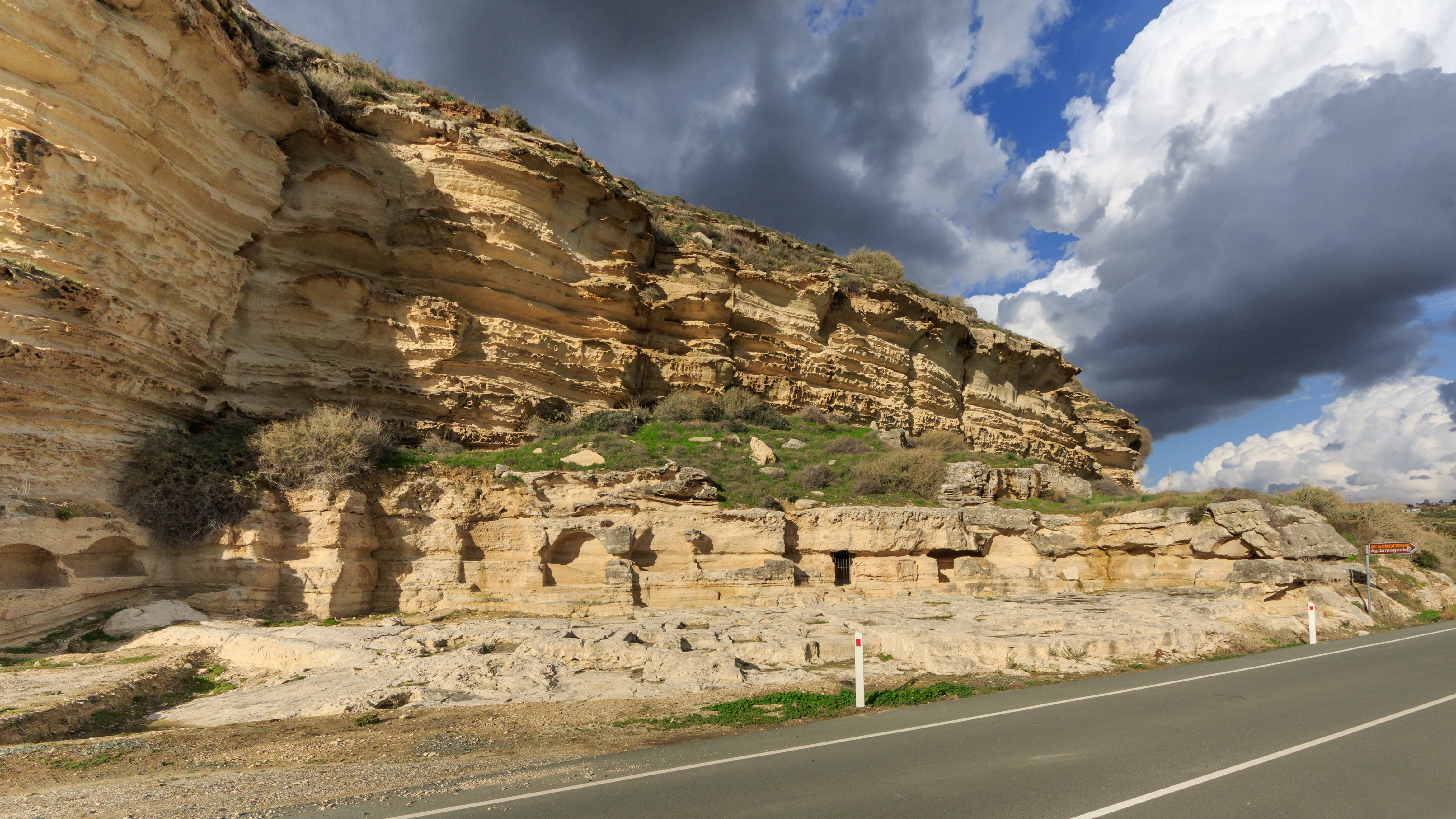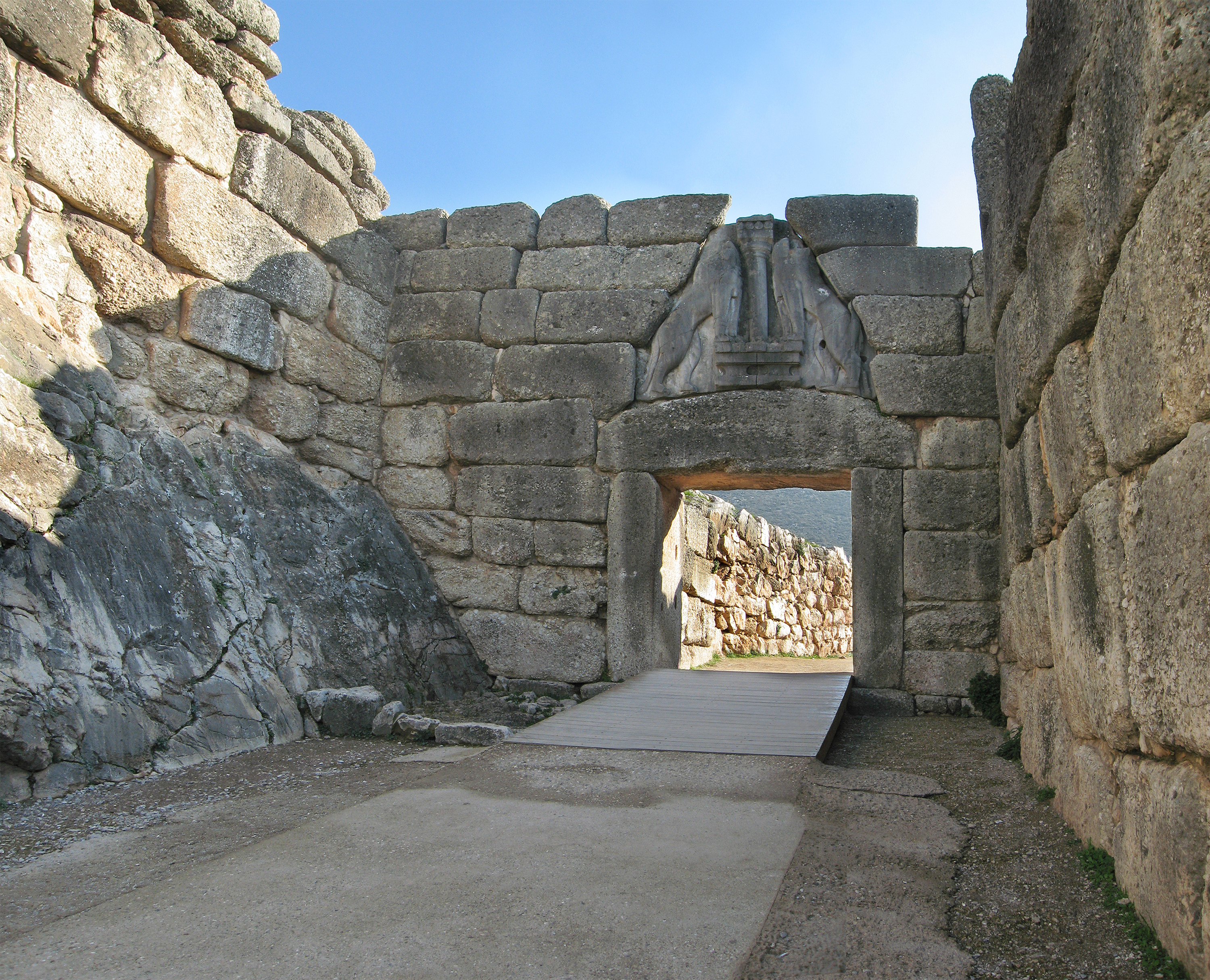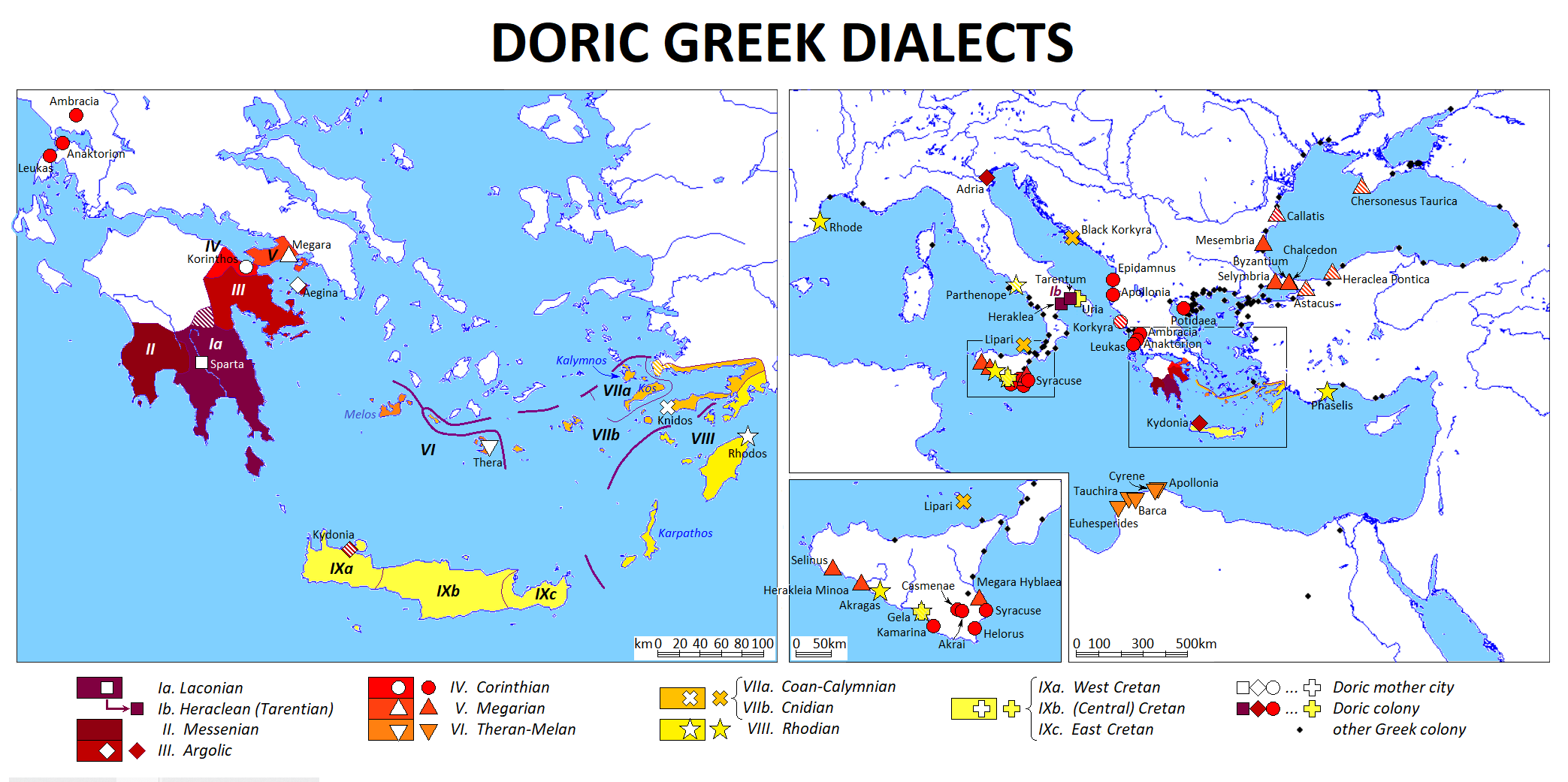|
Arcadocypriot Greek
Arcadocypriot, or southern Achaean, was an ancient Greek dialect spoken in Arcadia, in the central Peloponnese, and in Cyprus. Its resemblance to Mycenaean Greek, as it is known from the Linear B corpus, indicates that they are closely related to it, and belong to the same dialect group, known as Achaean. In Cyprus the dialect was written solely using the Cypriot syllabary. The most extensive surviving text of the dialect is the Idalion Tablet. A significant literary source on the vocabulary comes from the lexicon of 5th century AD grammarian Hesychius. History The prevailing dialect spoken in southern Greece (including Achaea, the Argolid, Laconia, Crete, and Rhodes) at the end of the Bronze Age, was Proto-Arcadocypriot. The Mycenaean and Arcadocypriot dialects belong to the same group, known as Achaean. Certain common innovations of Arcadian and Cypriot, as attested in the first millennium BC, indicate that they represent vernaculars that had slightly diverged from the My ... [...More Info...] [...Related Items...] OR: [Wikipedia] [Google] [Baidu] |
Arcadia (ancient Region)
Arcadia (; ) is a region in the central Peloponnese, Greece. It takes its name from the mythological character Arcas, and in Greek mythology it was the home of the gods Hermes and Pan. In European Renaissance arts, Arcadia was celebrated as an unspoiled, harmonious wilderness; as such, it was referenced in popular culture. The modern regional unit of the same name more or less overlaps with the historical region, but is slightly larger. History Arcadia was gradually linked in a loose confederation that included all the Arcadian towns and was named League of the Arcadians. In the 7th century BC, it successfully faced the threat of Sparta and the Arcadians managed to maintain their independence. They participated in the Persian Wars alongside other Greeks by sending forces to Thermopylae and Plataea. During the Peloponnesian War, Arcadia allied with Sparta and Corinth. In the following years, during the period of the hegemony of Thebes, the Theban general Epaminondas re ... [...More Info...] [...Related Items...] OR: [Wikipedia] [Google] [Baidu] |
Lycurgus (Arcadia)
In Greek mythology, Lycurgus (; ), also Lykurgos or Lykourgos, was a king of Tegea in Arcadia. Family Lycurgus was the son of Aleus, the previous ruler of Tegea, and Neaera, daughter of Pereus, and thus, brother to the Argonauts Amphidamas, Cepheus, Auge and Alcidice. He married either Cleophyle, Eurynome or AntinoeScholia ad Apollonius Rhodius, 1.164 and fathered these sons: Ancaeus, Epochus, Amphidamas, and Iasius. Mythology Lycurgus was notorious for killing, by ambushing him, a warrior called Areithous. He attacked the man unexpectedly in a narrow passage where Areithous' famous club was useless. Lycurgus took Areithous' armor as spoils and wore it himself, but handed it over to Ereuthalion when he had grown old. In homer's Iliad Nestor recounts killing Ereuthalion in a battle between Pylos and Arcadia. According to scholia on the ''Argonautica'', Ereuthalion was also vanquished by Lycurgus, who laid an ambush against him and overcame him in the ensuing battle ... [...More Info...] [...Related Items...] OR: [Wikipedia] [Google] [Baidu] |
Hecatomb
In ancient Greece, a hecatomb (; ; ''hekatómbē'') was a sacrifice of 100 cattle (''hekaton'' "one hundred", ''bous'' "bull") to the Greek gods. In practice, as few as 12 could make up a hecatomb. Although originally the sacrifice of a hundred oxen in the religious ceremonies of the Greeks and Romans; later "hecatomb" came to describe a large number of any kind of animals devoted to sacrifice. Figuratively, "hecatomb" is used to describe the sacrifice or destruction by fire, tempest, disease, or the sword of any large number of persons or animals; and also of the wholesale destruction of inanimate objects, and even of mental and moral attributes. Ancient Greece Hecatombs were offered to Greek gods Hera, Athena, and Apollo during special religious ceremonies. [...More Info...] [...Related Items...] OR: [Wikipedia] [Google] [Baidu] |
Ancient Greek Units Of Measurement
Ancient Greek units of measurement varied according to location and epoch. Systems of ancient weights and measures evolved as needs changed; Solon and other lawgivers also reformed them ''en bloc''. Some units of measurement were found to be convenient for trade within the Mediterranean region and these units became increasingly common to different city states. The calibration and use of measuring devices became more sophisticated. By about 500 BC, Athens had a central depository of official weights and measures, the '' Tholos'', where merchants were required to test their measuring devices against official standards. Length Some Greek measures of length were named after parts of the body, such as the (''daktylos'', plural: ''daktyloi'') or finger (having the size of a thumb), and the ('' pous'', plural: ''podes'') or foot (having the size of a shoe). The values of the units varied according to location and epoch (e.g., in Aegina a ''pous'' was approximately , whereas in Athen ... [...More Info...] [...Related Items...] OR: [Wikipedia] [Google] [Baidu] |
Digamma
Digamma or wau (uppercase: Ϝ, lowercase: ϝ, numeral: ϛ) is an Archaic Greek alphabets, archaic letter of the Greek alphabet. It originally stood for the sound but it has remained in use principally as a Greek numeral for 6 (number), 6. Whereas it was originally called ''waw'' or ''wau'', its most common appellation in classical Greek is ''digamma''; as a numeral, it was called ''episēmon'' during the Byzantine era and is now known as ''stigma (letter), stigma'' after the Greek ligature, Byzantine ligature combining σ-τ as ϛ. Digamma or wau was part of the original archaic Greek alphabet as initially adopted from Phoenician alphabet, Phoenician. Like its model, Phoenician Waw (letter), waw, it represented the voiced labial-velar approximant and stood in the 6th position in the alphabet between epsilon and zeta. It is the consonantal doublet of the vowel letter upsilon (), which was also derived from waw but was placed near the end of the Greek alphabet. Digamma or wau ... [...More Info...] [...Related Items...] OR: [Wikipedia] [Google] [Baidu] |
San (letter)
San () is an archaic letter of the Greek alphabet. Its shape is similar to Latin and Greek Mu (Greek letter), mu (), and can be described as a sigma () turned sideways. It was used as an alternative to sigma to denote the sound . Unlike sigma, whose position in the alphabet is between Rho (letter), rho and Tau (letter), tau, san appeared between Pi (letter), pi and Qoppa (letter), koppa in alphabetic order. In addition to denoting the archaic character, the name "san" also came to be used for sigma itself. Historical use Sigma and san The existence of the two competing letters sigma and san is traditionally believed to have been due to confusion during the adoption of the Greek alphabet from the Phoenician alphabet, Phoenician script, because Phoenician had more sibilant sounds than Greek had. According to one theory, the distribution of the sibilant letters in Greek is due to pair-wise confusion between the sounds and alphabet positions of the four Phoenician sibilant sign ... [...More Info...] [...Related Items...] OR: [Wikipedia] [Google] [Baidu] |
Kourion
Kourion (; ) was an important ancient Greek city-state on the southwestern coast of the island of Cyprus. In the twelfth century BCE, after the Mycenaean Greece#Collapse or Postpalatial Bronze Age (c. 1200–1050 BC), collapse of the Mycenaean palaces, Greek settlers from Argos, Peloponnese, Argos arrived on this site. In the fourth century, Kourion suffered from five heavy earthquakes, but the city was mostly rebuilt. The acropolis of Kourion, located 1.3 km southwest of Episkopi, Limassol, Episkopi and 13 km west of Limassol, is located atop a limestone promontory nearly 100 metres high along the coast of Episkopi Bay. The Kourion archaeological area lies within the British Overseas Territory of Akrotiri and Dhekelia and is managed by the Department of Antiquities (Cyprus), Cyprus Department of Antiquity. History of Kourion Early history of the area The earliest identified occupation within the Kouris River valley is at the hilltop settlement of Sotira-Teppes, loca ... [...More Info...] [...Related Items...] OR: [Wikipedia] [Google] [Baidu] |
Salamis, Cyprus
Salamis (; ; ) was an ancient Greek city-state on the east coast of Cyprus, at the mouth of the river Pedieos, 6 km north of modern Famagusta. According to tradition, the founder of Salamis was Teucer, son of Telamon, king of the Greek island of Salamis, who could not return home after the Trojan War because he had failed to avenge his brother Ajax. History Early history The earliest archaeological finds go back to the eleventh century BC (Late Bronze Age III). The copper ores of Cyprus made the island an essential node in the earliest trade networks, and Cyprus was a source of the orientalizing cultural traits of mainland Greece at the end of the Greek Dark Ages, hypothesized by Walter Burkert in 1992. Children's burials in Canaanite jars indicate a Phoenician presence. A harbour and a cemetery from this period have been excavated. The town is mentioned in Assyrian inscriptions as one of the kingdoms of ''Iadnana'' (Cyprus). In 877 BC, an Assyrian army reached the Med ... [...More Info...] [...Related Items...] OR: [Wikipedia] [Google] [Baidu] |
Mycenaean Greece
Mycenaean Greece (or the Mycenaean civilization) was the last phase of the Bronze Age in ancient Greece, spanning the period from approximately 1750 to 1050 BC.. It represents the first advanced and distinctively Greek civilization in mainland Greece with its palatial states, urban organization, works of art, and writing system.. The Mycenaeans were mainland Greek peoples who were likely stimulated by their contact with insular Minoan Crete and other Mediterranean cultures to develop a more sophisticated sociopolitical culture of their own. The most prominent site was Mycenae, after which the culture of this era is named. Other centers of power that emerged included Pylos, Tiryns, and Midea in the Peloponnese, Orchomenos, Thebes, and Athens in Central Greece, and Iolcos in Thessaly. Mycenaean settlements also appeared in Epirus, Macedonia, on islands in the Aegean Sea, on the south-west coast of Asia Minor, and on Cyprus, while Mycenaean-influenced settlements appear ... [...More Info...] [...Related Items...] OR: [Wikipedia] [Google] [Baidu] |
Doric Greek
Doric or Dorian (), also known as West Greek, was a group of Ancient Greek dialects; its Variety (linguistics), varieties are divided into the Doric proper and Northwest Doric subgroups. Doric was spoken in a vast area, including northern Greece (Acarnania, Aetolia, Epirus, Ozolian Locris, western and Opuntian Locris, eastern Locris, Phocis (ancient region), Phocis, Doris (Greece), Doris, and possibly Macedonia (ancient kingdom), ancient Macedonia), most of the Regions of ancient Greece#Peloponnese, Peloponnese (Achaea (ancient region), Achaea, Ancient Elis, Elis, Messenia (ancient region), Messenia, Laconia, Argolid, Aegina, Corinthia (ancient region), Corinthia, and Megara), the Southern Aegean (Kythira, Milos, Santorini, Thera, Crete, Karpathos, and Rhodes), as well as the colonies of some of those regions in Cyrene, Libya, Cyrene, Magna Graecia, the Greek colonisation#Black Sea and Propontis, Black Sea, Greek colonisation#Ionian Sea, Adriatic Sea, and Illyria, the Ionian Sea ... [...More Info...] [...Related Items...] OR: [Wikipedia] [Google] [Baidu] |
Bronze Age
The Bronze Age () was a historical period characterised principally by the use of bronze tools and the development of complex urban societies, as well as the adoption of writing in some areas. The Bronze Age is the middle principal period of the three-age system, following the Stone Age and preceding the Iron Age. Conceived as a global era, the Bronze Age follows the Neolithic, with a transition period between the two known as the Chalcolithic. The final decades of the Bronze Age in the Mediterranean basin are often characterised as a period of widespread societal collapse known as the Late Bronze Age collapse (), although its severity and scope are debated among scholars. An ancient civilisation is deemed to be part of the Bronze Age if it either produced bronze by smelting its own copper and alloying it with tin, arsenic, or other metals, or traded other items for bronze from producing areas elsewhere. Bronze Age cultures were the first to History of writing, develop writin ... [...More Info...] [...Related Items...] OR: [Wikipedia] [Google] [Baidu] |
Kouklia
Kouklia (, ) is a village in the Paphos District, about east from the city of Paphos on the Mediterranean island of Cyprus. The village is built in the area of "Palaepaphos" () (Paphos#Old Paphos, Old Paphos), mythical birthplace of Aphrodite, Greek goddess of love and beauty, which became the centre for her worship in the ancient world. Because of its ancient religious significance and architecture, Kouklia was inscribed on the UNESCO World Heritage List along with Kato Paphos in 1980. Recent archaeology has been continuing on the site since 2006, and remains of the ancient city and the sanctuary can be seen today. History From around 1200 BC, Palaepaphos was a major religious centre famous all over Cyprus, but also throughout the Mediterranean. Nevertheless, it also became a city and seat of power about which still little is known today. Paphos was also a kingdom and the city was capital of the region. When the last King of Palaepaphos, Nicocles (Paphos), Nicocles, moved hi ... [...More Info...] [...Related Items...] OR: [Wikipedia] [Google] [Baidu] |




